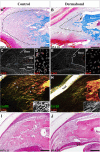Epidermal closure regulates histolysis during mammalian (Mus) digit regeneration
- PMID: 27499872
- PMCID: PMC4895321
- DOI: 10.1002/reg2.34
Epidermal closure regulates histolysis during mammalian (Mus) digit regeneration
Abstract
Mammalian digit regeneration progresses through consistent stages: histolysis, inflammation, epidermal closure, blastema formation, and finally redifferentiation. What we do not yet know is how each stage can affect others. Questions of stage timing, tissue interactions, and microenvironmental states are becoming increasingly important as we look toward solutions for whole limb regeneration. This study focuses on the timing of epidermal closure which, in mammals, is delayed compared to more regenerative animals like the axolotl. We use a standard wound closure device, Dermabond (2-octyl cyanoacrylate), to induce earlier epidermal closure, and we evaluate the effect of fast epidermal closure on histolysis, blastema formation, and redifferentiation. We find that fast epidermal closure is reliant upon a hypoxic microenvironment. Additionally, early epidermal closure eliminates the histolysis stage and results in a regenerate that more closely replicates the amputated structure. We show that tools like Dermabond and oxygen are able to independently influence the various stages of regeneration enabling us to uncouple histolysis, wound closure, and other regenerative events. With this study, we start to understand how each stage of mammalian digit regeneration is controlled.
Keywords: Blastema; digit; hypoxia; mouse; regeneration.
Figures





Similar articles
-
The mammalian blastema: regeneration at our fingertips.Regeneration (Oxf). 2015 Jun 9;2(3):93-105. doi: 10.1002/reg2.36. eCollection 2015 Jun. Regeneration (Oxf). 2015. PMID: 27499871 Free PMC article. Review.
-
Microcomputed tomography staging of bone histolysis in the regenerating mouse digit.Wound Repair Regen. 2023 Jan;31(1):17-27. doi: 10.1111/wrr.13054. Epub 2022 Oct 4. Wound Repair Regen. 2023. PMID: 36177656
-
Blastema formation and periosteal ossification in the regenerating adult mouse digit.Wound Repair Regen. 2018 May;26(3):263-273. doi: 10.1111/wrr.12666. Epub 2018 Oct 16. Wound Repair Regen. 2018. PMID: 30120800
-
Macrophages are required to coordinate mouse digit tip regeneration.Development. 2017 Nov 1;144(21):3907-3916. doi: 10.1242/dev.150086. Epub 2017 Sep 21. Development. 2017. PMID: 28935712 Free PMC article.
-
The axolotl limb blastema: cellular and molecular mechanisms driving blastema formation and limb regeneration in tetrapods.Regeneration (Oxf). 2015 May 11;2(2):54-71. doi: 10.1002/reg2.32. eCollection 2015 Apr. Regeneration (Oxf). 2015. PMID: 27499868 Free PMC article. Review.
Cited by
-
Osteoclast-mediated resorption primes the skeleton for successful integration during axolotl limb regeneration.Elife. 2022 Oct 11;11:e79966. doi: 10.7554/eLife.79966. Elife. 2022. PMID: 36218256 Free PMC article.
-
Limb blastema formation: How much do we know at a genetic and epigenetic level?J Biol Chem. 2023 Feb;299(2):102858. doi: 10.1016/j.jbc.2022.102858. Epub 2022 Dec 31. J Biol Chem. 2023. PMID: 36596359 Free PMC article. Review.
-
Level-specific amputations and resulting regenerative outcomes in the mouse distal phalanx.Wound Repair Regen. 2017 May;25(3):443-453. doi: 10.1111/wrr.12544. Epub 2017 Jul 5. Wound Repair Regen. 2017. PMID: 28493324 Free PMC article.
-
Male Down syndrome Ts65Dn mice have impaired bone regeneration.Bone. 2025 Mar;192:117374. doi: 10.1016/j.bone.2024.117374. Epub 2024 Dec 13. Bone. 2025. PMID: 39675408 Free PMC article.
-
Comparative analysis of ear-hole closure identifies epimorphic regeneration as a discrete trait in mammals.Nat Commun. 2016 Apr 25;7:11164. doi: 10.1038/ncomms11164. Nat Commun. 2016. PMID: 27109826 Free PMC article.
References
-
- Arnett, T.R. (2010). Acidosis, hypoxia and bone. Archives of Bio and Bio, 503, 103–109. - PubMed
-
- Arnett, T.R. , Gibbons, D.C. , Utting, J.C. , Orriss, I.R. , Hoebertz, A. , Rosendaal, M. et al. (2003). Hypoxia is a major stimulator of osteoclast formation and bone resorption. Journal of Cellular Physiology, 196, 2–8. - PubMed
-
- Boraldi, F. , Annovi, G. , Carraro, F. , Naldini, A. , Tiozzo, R. , Sommer, P. , et. al. (2007). Hypoxia influences the cellular cross‐talk of human dermal fibroblasts. A proteomic approach. Biochimica et Biophysica Acta 1774, 1402–13. - PubMed
-
- Borgens, R.B. (1982). Mice regrow the tips of their foretoes. Science, 217, 747–750. - PubMed
LinkOut - more resources
Full Text Sources
Other Literature Sources
